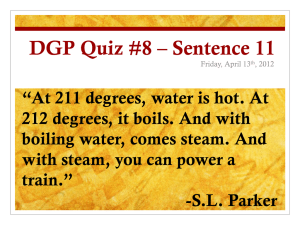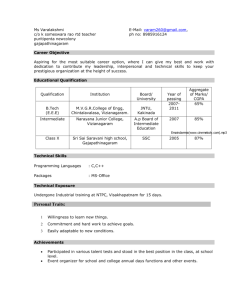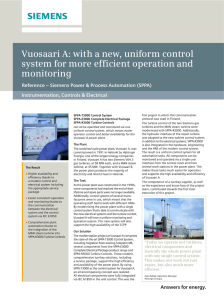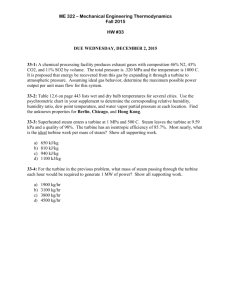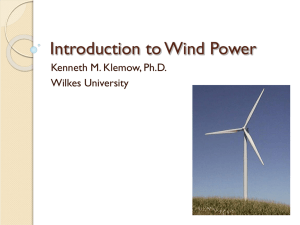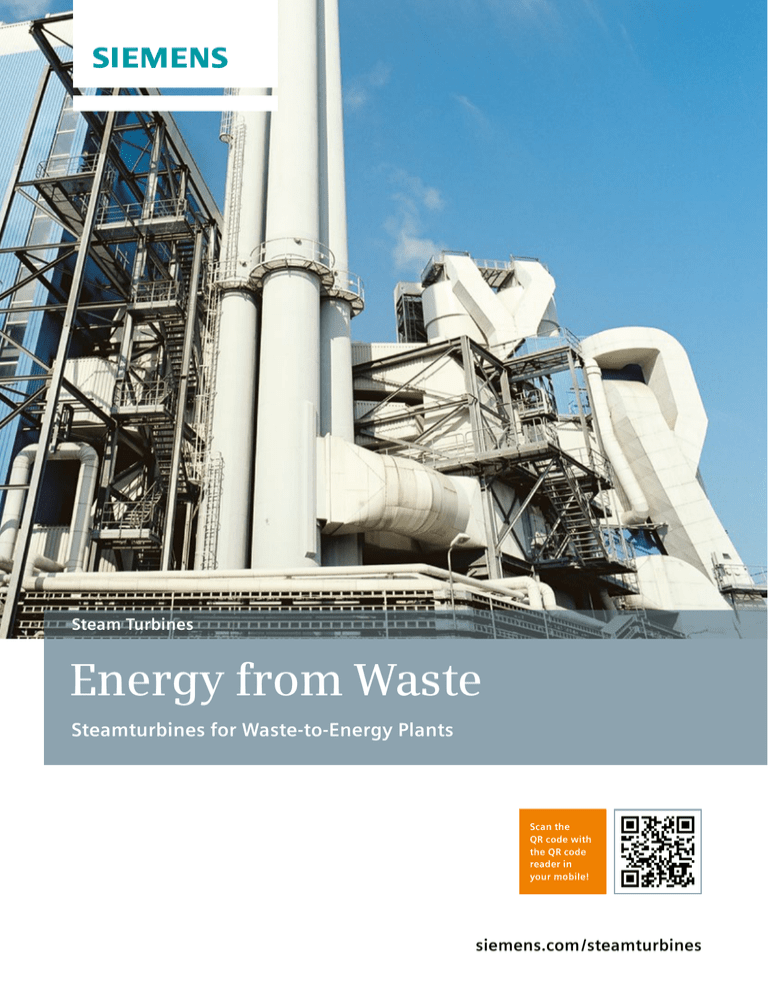
Steam Turbines
Energy from Waste
Steamturbines for Waste-to-Energy Plants
Scan the
QR code with
the QR code
reader in
your mobile!
siemens.com / steamturbines
2
Energy from Waste
Not only in times of increasing urbanization and population or of the growing industrialization of countries
becomes waste treatment more and more demanding.
Each year thousands of acres of land are lost to landfills.
The methane produced from decomposing waste is a
potent greenhouse gas. And the costs associated with
using a landfill are rising as cities and counties truck their
waste ever farther away.
Reasons like these, and others, are causing municipalities
to re-evaluate the benefits of energy-from-waste facilities.
Some municipalities are considering new facilities and
others are looking at expanding the ones they have.
­ dditionally, more and more governments establish subA
sidaries for an ecological friendly waste treatment.
Energy from Waste (EfW) is often viewed as primarily a
waste management solution rather than a valuable energy
resource. Consequently, its full potential has not always
been realized. Still, worldwide more than 2,200 EfW
plants with an overall capacity of about 255 million tons
per year are installed.
The heart of virtually every EfW plant is a steam turbine
generating electrical power out of the heat from the
combustion of waste. An efficient and reliable steam turbine is the key to harnessing energy from waste and provides many benefits.
3
Environmental Benefits
EfW plants are part of the environmental portfolio and
contribute significantly towards reducing carbon emissions and meeting renewable energy targets. They have
a very good sustainability and greenhouse gas saving
characteristics, as they make further use of materials that
have already been discarded. Waste seen as source for
energy saves the limited fossil fuel resources for the production of sustainable energy.
Efficiency
The plant makes use of up to 75 % of the calorific value
of the fuel, since all of the steam produced during incineration is utilized. The high usage factor is also a result of
the most advanced techniques in thermal waste disposal.
An even higher investment in the power generating technology employing the latest design of steam turbines
can result in up to 4 % more output compared to the wellproven standard design.
Sustainability
Waste is produced by mankind. Re-cycling and waste
avoidance are still the major ways of waste reduction.
The beyond that existing community refuse can be a
­valuable energy source. One kilogram of waste has
a ­calorific value of around 10,000 kJ and can ideally
replace about 0.25 liters of high-grade fuel oil.
Reliability
EfW plant use waste incineration as a valuable source
of fuel. Thus, they help to reduce the dependency on
energy imports. When used for electricity generation,
these technologies have a steady and controllable output,
sometimes referred to as providing “base load” power.
Ludwigslust Thermal Waste
Treatment Plant
Ludwigslust, Germany
In operation since 2006, the thermal
waste treatment plant has a capacity of
50,000 t/a. The plant delivers heat of
9,600 kj/a treating the waste of 50,000
citizens. Operator RWE runs the plant
non-stop in five shifts for 24 hours a day.
Steam Turbine: SST-110
Power output: 3.5 MW
Total plant capacity: 50,000 t/a
4
5
GÄRSTAD PLANT,
Linköping, Sweden
At the Gärstad waste incineration
plant, operated by Tekniska Verken, a
total of 420,000 tons of sorted waste
per year is incinerated for energy
recovery. The heat of the waste incineration is used for district heating in
Linköping and other local communities. Since 2011, two SST-110 steam
turbines are used to produce electricity in addition. Both, electricity and
district heat are sold via the energy
exchange market, and power and
heat loads can be balanced to run the
plant always with maximum
profitability.
Steam turbine: 2x SST-110
El. power output: up to 11.5 MWe
Heat capacity: 65 – 83 MWth
District Heating and Cooling
District heating and cooling using a cogeneration system
is one of the most efficient applications of a power plant.
Usually a plant generates thermal energy at a centralized
location and distributes steam to a larger number of buildings for space and water heating. District heating plants
can provide higher efficiencies and better pollution control
than stand-alone solutions. The process is normally governed by the total heat load and electrical energy is supplied as an additional benefit.
6
Whether a cogeneration application is for a district energy
system, a heating or cooling system, or any other application, Siemens expertise ensures that your project will
maintain optimal performance in markets with demand
fluctuation. Any Siemens steam turbine can also feature
extraction customization as required. The Siemens engineering staff is expert at designing turbines which can
maximize output and plant value for seasonal load and
demand variations.
Solutions: High Efficient
Steam Turbines
Whichever turbine is used in your EfW plant, a Siemens
steam turbine will ensure high plant performance. These
flexible machines can even optimize electric output in
plants which have steam parameters affected by inconsistent feedstock moisture content. This is possible by integrating industry-leading steam cycle technology.
Siemens Steam Turbines
The Siemens industrial steam turbine portfolio can be
used with any waste-fired steam boiler to generate power
from 75 kWe up to any size. The Siemens experts will assist
in selecting the optimum turbine that meets all application requirements while at the same time it minimizes the
investment costs.
The Siemens steam turbine portfolio is characterized by
efficiency and durability. Turbine generator sets have
been deployed in EfW plants in the past decade with an
outstanding record of applicability and reliability. Siemens
can also supply your steam turbine with auxiliary equipment such as generator, a condenser system, monitoring
and control systems and power transmission and distribution equipment.
Leading Technology
Siemens turbines are available for back-pressure or condensing operation in a single or multi-stage design. They
can also be equipped with single or multiple controlled
(pass-out) and uncontrolled extractions (bleeds) to satisfy
particular process or district heating as well as cooling
requirements. Additionally, Siemens offers turbine-generator packages with a reheat feature, further optimizing
plant performance and efficiency.
Afval Energie Bedrijf
Amsterdam, Netherlands
Afval Energie Bedrijf (AEB; Waste and
Energy Company Amsterdam) burns 1.7
million tonnes of waste per year and
has recently increased its energy generation efficiency from 22% to 31%. This
8% increase resulted from installing a
new SST-700 with a steam reheat system. AEB not only generates power
from Amsterdam’s municipal waste, but
also recovers and sells materials from
the waste stream such as metals and
gypsum.
Steam turbine: SST-700, Reheat
Power output: 74 MW
Inlet pressure: 125 bar / 1,813 psi
Inlet temperature: 440 °C / 824 °F
Fuel: Municipal solid waste
Capacity: 1.5 Mio + 850,000 t, each
line with 93.6 MWth
7
Turbines with reheat can improve overall plant efficiency
by up to 3%, further mitigating the release of harmful
emissions by burning less fuel. Each turbine, along with
its customized features, is built to meet specific demands.
Standardized and pre-designed Steam Turbines
Siemens offers a comprehensive range of pre-designed
steam turbines up to 12 MW. These innovative but economical machines have a simple modular design which
facilitates optimization of performance for the required
application. For optimal configuration, we have different
but fully compatible design series to draw upon, enabling
us to match your needs as exactly as possible.
Customized Steam Turbines
Our industrial steam turbines up to 250 MW meet customer requirements for economic installation and operation as well as providing excellent flexibility for complex
industrial processes.
Versatile, reliable and proven steam turbines
Maximum flexibility with predefined components
Customized turbine configuration
Single and multi-casing solutions
Flexible casing concepts
Pre-designed and modular design
Predefined components, modular design
Innovative product design
Controlled and uncontrolled extractions
High flexibility
High availablity, short delivery time,
Economic installation and operation
Lincolnshires’s Energy from Waste
Facility, Lincoln, UK
This new facility (in operation since 2014),
commissioned by Lincolnshire County Council,
built by CNIM and operated by FCC Environment
Ltd, provides a safe, sustainable and affordable
waste treatment solution to dispose of household
waste, with a useful and profitable by-product –
electricity. It burns 150,000 t of waste a year and
has an electrical power output of 15.25 MW and a
heat power of 10 MW.
Steam turbine: SST-300
Power output: 15.25 MW
Speed: 5,300 rpm
Live steam pressure: 58 bar / 841 psi
Live steam temperature: 397°C / 746°F
Exhaust steam pressure: 0.07 bar / 1 psi
8
6
2
3
1
4
5
Scheme of a EfW plant: 1 waste treatment, 2 boiler, 3 water steam circle, 4 steam turbine and generator,
5 flue gas treatment, 6 emission control
Reheat Improves Efficiency
Integrating a steam reheat system into a EfW plant is one
of the best ways to increase overall plant performance.
With the Siemens reheat turbine package, live steam is
run through a high pressure (HP) turbine, sent back to the
steam generator to increase steam temperature, then run
through a low pressure (LP) turbine. Raising the temperature of steam that is going from a high to a low pressure turbine allows for greater output using the same
amount of fuel. Geared single-casing reheat solutions up
to 60 MW are also available in the Siemens portfolio.
9
Siemens steam turbines
The complete product portfolio
Power Output ( MW )
Type
0.5
SST-040*
SST-050*
1
2
3
5
7
10
15
20
30
50
75 100
150
250
0.3
0.75
SST-060*
SST-110*
6
7
SST-111*
12
SST-150*
SST-200
SST-300*
SST-400*
SST-500
SST-600*
SST-700
20
10
50
65
100
150
175
SST-800*
250
SST-900
250
SST-3000
250
SST-5000
*Steam turbines typically used for WtE plants
10
750
750
Published by and copyright © 2015:
Siemens AG
Power and Gas
Freyeslebenstrasse 1
91058 Erlangen, Germany
Siemens AG
Steam Turbines
Lutherstrasse 51
02826 Goerlitz, Germany
Siemens Energy Inc.
10730 Telge Road
Houston, Texas 77095, USA
For more information, please contact
our Customer Support Center.
Phone +49 180 524 70 00
Fax: +49 180 524 24 71
(Charges depending on provider)
Email: support.energy@siemens.com
Power and Gas
Order No. E50001-G410-A124-X-4A00
Printed in Germany
Dispo 34808, c4bs 7489
K12 150021, WÜ WS 0715
Printed on elementary chlorine-free
bleached paper.
All rights reserved.
Trademarks mentioned in this
document are the property of
Siemens AG, its affiliates, or their
respective owners.
Subject to change without prior
notice. The information in this
document contains general
descriptions of the technical
options available, which may not
apply in all cases. The required
technical options should therefore
be specified in the contract.

